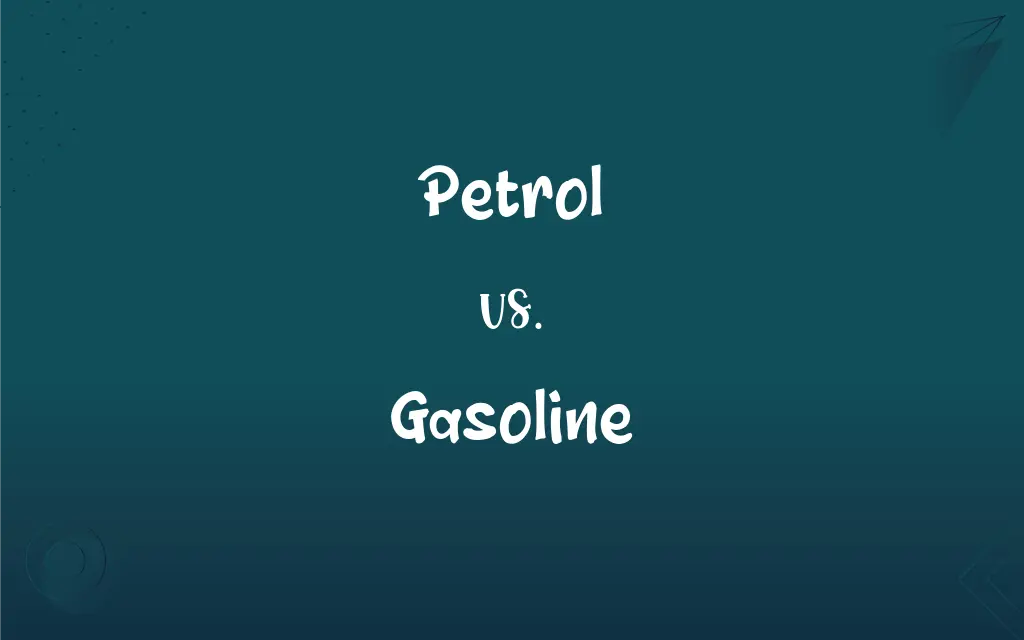Petrol vs. Gasoline: What's the Difference?
Edited by Janet White || By Harlon Moss || Updated on May 30, 2024
Petrol and gasoline refer to the same fuel type, with "petrol" commonly used in British English and "gasoline" in American English.

Key Differences
Petrol is the term predominantly used in British English to describe the fuel used in internal combustion engines. It's derived from "petroleum," highlighting its origin from crude oil. Gasoline, on the other hand, is the American English term for the same substance, often abbreviated to "gas" in everyday conversation.
The usage of "petrol" is common in countries like the UK, Australia, and India, aligning with British English conventions. Conversely, "gasoline" is used in the United States and Canada, adhering to American English norms. Despite the different terminology, both refer to the same hydrocarbon mixture used to power vehicles.
In the automotive industry, vehicles are designed to use petrol or gasoline, depending on the market they are sold in. While the term "petrol" might be seen at service stations in the UK, "gasoline" is displayed at gas stations in the US. This difference in terminology is purely linguistic, with no impact on the chemical composition or function of the fuel.
Marketing and branding of fuels also reflect these linguistic preferences. For example, British companies like BP might use "petrol" in their advertising, while American companies like ExxonMobil use "gasoline." This ensures that the local population understands the product being offered.
Comparison Chart
Common Usage
UK, Australia, and many countries
USA, Canada
ADVERTISEMENT
Abbreviation
Rarely abbreviated
Often abbreviated as "gas"
Etymology
Derived from "petroleum"
Originally a trademarked name
Compound Word Usage
Less common
More common (e.g., gas station)
Associated Terminology
Petrol station, petrol pump
Gas station, gas pump
Petrol and Gasoline Definitions
Petrol
Petrol is associated with greenhouse gas emissions.
Burning petrol releases carbon dioxide into the atmosphere.
ADVERTISEMENT
Gasoline
Gasoline combustion is a significant source of pollution.
Reducing gasoline consumption can mitigate environmental impact.
Petrol
Petrol is a liquid fuel used in internal combustion engines.
She filled her car with petrol before the road trip.
Gasoline
Gasoline is a fossil fuel derived from petroleum used to run internal combustion engines.
The price of gasoline has been fluctuating recently.
Petrol
Petrol contains hydrocarbons and may include additives.
Some types of petrol contain additives to improve engine performance.
Gasoline
Gasoline can be found in various forms such as regular, premium, and mid-grade.
Different vehicles may require different grades of gasoline.
Petrol
Petrol originates from the refinement of crude oil.
Petrol is produced through a distillation process at refineries.
Gasoline
Gasoline can vary in octane levels affecting engine performance.
High-octane gasoline is often recommended for performance vehicles.
Petrol
Petrol is used in various vehicular engines.
The motorbike needs premium petrol for optimal performance.
Gasoline
Gasoline stations are widespread and provide various services.
They stopped at a gasoline station to refuel and buy snacks.
Petrol
Petroleum, a fluid consisting of a mixture of refined petroleum hydrocarbons, primarily consisting of octane, commonly used as a motor fuel.
Petrol
Gasoline.
Petrol
(informal) A motor vehicle powered by petrol (as opposed to diesel).
Petrol
Petroleum.
Petrol
A volatile flammable mixture of hydrocarbons (hexane and heptane and octane etc.) derived from petroleum; used mainly as a fuel in internal-combustion engines
FAQs
What is petrol used for?
Petrol is commonly used as a fuel for internal combustion engines in vehicles.
Is gasoline the same as petrol?
Yes, gasoline and petrol refer to the same fuel type but are used in American and British English, respectively.
Why is gasoline sometimes called "gas" even though it's a liquid?
The term "gas" is a short, colloquial abbreviation of gasoline, used commonly in the United States.
Is petrol available in different grades?
Yes, petrol is available in various grades, which are primarily differentiated by their octane ratings.
Are there electric alternatives to gasoline-powered vehicles?
Yes, there are various electric and hybrid vehicles available that do not rely solely on gasoline.
Why do petrol prices fluctuate?
Petrol prices fluctuate due to various factors, including crude oil prices, supply and demand, and geopolitical events.
Is petrol harmful to the environment?
Yes, burning petrol releases carbon dioxide, contributing to air pollution and climate change.
Is there an alternative to using gasoline for vehicles?
Yes, alternatives include electric power, hydrogen fuel cells, and alternative fuels like ethanol.
How is petrol stored safely?
Petrol should be stored in approved containers, in a well-ventilated area, away from living spaces and ignition sources.
What are the dangers associated with petrol?
Petrol is highly flammable and can be harmful or fatal if swallowed or inhaled in high concentrations.
Can you mix different octanes of petrol?
Yes, mixing different octanes of petrol is generally safe but it's best to stick to the manufacturer's recommendation.
What happens when gasoline expires?
When gasoline "expires" or ages, it can oxidize and form gums and varnishes that can foul an engine.
Is gasoline available worldwide?
Yes, gasoline is available worldwide, though availability and quality can vary by region.
Can petrol be used in jet engines?
No, petrol is not used in jet engines, which typically use a type of kerosene-based jet fuel.
Can gasoline be used in fuel oil heating systems?
No, gasoline should not be used in heating systems designed for fuel oil as it is more volatile and can be dangerous.
Can a gasoline engine run on diesel?
No, a gasoline engine cannot run on diesel and trying to do so can cause significant damage.
What additives are found in gasoline?
Gasoline may contain additives for improving combustion, cleaning, and stabilizing the fuel during storage.
Can I use premium petrol in any car?
While you can use premium petrol in any car, it’s best to follow the fuel grade recommended in the vehicle's manual.
How is gasoline transported?
Gasoline is typically transported via pipelines, trucks, or ships, depending on the region and infrastructure.
How is petrol made?
Petrol is made by distilling crude oil, and it may then be blended with other substances to create various grades.
About Author
Written by
Harlon MossHarlon is a seasoned quality moderator and accomplished content writer for Difference Wiki. An alumnus of the prestigious University of California, he earned his degree in Computer Science. Leveraging his academic background, Harlon brings a meticulous and informed perspective to his work, ensuring content accuracy and excellence.
Edited by
Janet WhiteJanet White has been an esteemed writer and blogger for Difference Wiki. Holding a Master's degree in Science and Medical Journalism from the prestigious Boston University, she has consistently demonstrated her expertise and passion for her field. When she's not immersed in her work, Janet relishes her time exercising, delving into a good book, and cherishing moments with friends and family.































































